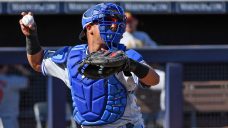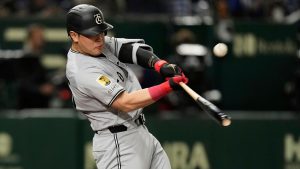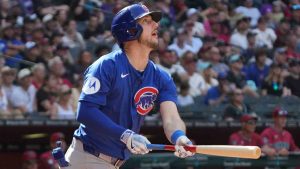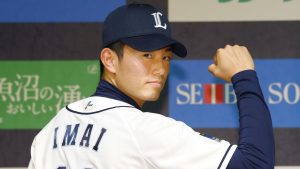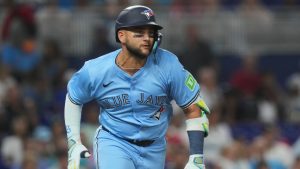KANSAS CITY — When Matt Gage first met Matt Buschmann, he was a stubborn 25-year-old starter in the San Francisco Giants system playing his way out of affiliated baseball. It was 2018 and Gage had been hitting his head against the wall for five seasons since he’d been drafted, trying to figure out how to make his high-80’s sinker play effectively down in the zone. That was all old school developers had told him to do. Locate down. Throw strikes. Try to make your secondary stuff move. Oh, it isn’t working? Maybe you should pitch better.
Buschmann’s advice was a little different. He entered a room with several Giants minor-leaguers like Gage during spring training that year — Buschmann’s first as the club’s assistant director of player development after his playing career came to an end in the Toronto Blue Jays organization the season prior — preaching a more empirical approach. Oh, it isn’t working? Maybe we should look for reasons why.
But to Gage and his teammates, the language Buschmann spoke was unrecognizable. Degrees on approach angles; inches of horizontal and vertical movement; revolutions per minute. Buschmann was trying to explain tunnelling, the importance of release points, spin mirroring. Gage didn’t understand a word of it.
“We were all like, ‘We have no idea what you're talking about, dude. What even is this? This isn’t baseball,’” Gage remembers. “And then, all of a sudden, four years later, it's all of baseball. That stuff he was talking about is the entire game. It's kind of crazy how he was so ahead of the times. He saw this coming before any of us did.”
A year later, Gage was pitching in Mexico — where they really didn’t give a damn about spin rates and seam-shifted wake — while Buschmann was being hired by the Blue Jays as the club’s director of pitching development and major-league bullpen coach. And three years after that, as free agency opened last November, Gage was listening to a Buschmann pitch once again — here’s why you should come join us with the Blue Jays; here’s how we can help you get better — this time with a much more open mind.
It's what happened in between that allowed Gage to make his big-league debut at the age of 29 last week, striking out two over a scoreless inning of relief at the end of a Blue Jays blowout over the Kansas City Royals. During two years spent outside affiliated ball, Gage came to terms with the fact that what first got him there wasn’t going to take him any further. And that if he still wanted to throw baseballs for a living, he’d need to do things differently.
"I was like, 'All right, if my career's over in the States, how do I get to Asia? How do I get back to a higher level?'" He says. "Like, 'OK, yeah, you can play professionally in Mexico and have a decent career. But how do you get better?' That was really the goal. Get better. So, I just started throwing things at a wall to see what stuck."
The left-hander spent an entire year languishing in Mexico and was preparing for another when the COVID-19 pandemic halted baseball in early 2020. Stuck at home with nothing else to do, Gage started messing around with different mechanics on a mound near his home, searching for anything to juice a little more life out of his arm. One night, he was watching Chicago White Sox starter Lucas Giolito throw with a short-arm delivery. Giolito’s command looked much better than Gage remembered it from watching him in the minors — and he hadn’t lost anything off his fastball. The next day, with his wife, Paige, standing in the batter’s box, Gage gave it a shot.
Paige, who played softball at Siena College where Gage pitched for three years, said the ball looked great out of his hand. His catcher said so, too. Not long after, taking the mound for the first time in nearly a year during an independent league game, Gage tried the short-action delivery in competition.
“First pitch was 94,” Gage says. “I’ve never thrown 94 miles-per-hour in my life. So, I was like, these mechanics obviously work. And they’re here to stay. It was crazy.”
Gage took his new arm action back to Mexico for winter ball that year and put enough velocity on film for the Arizona Diamondbacks to bring him in for a bullpen ahead of 2021 spring training. And he did enough in that bullpen to earn a minor-league deal, something no team would give him over the two years prior. Gage transitioned to a bulk relief role, spent some time at double-A, and finished his year pitching for the Reno Aces in triple-A West, a circuit made up mostly of teams from the former Pacific Coast League, notorious for its hitter-friendly environments.
That’s a tough place to make the best account of yourself as a pitcher. And Gage’s 2021 triple-A numbers — a 5.57 ERA over 32.1 innings with a 27 per cent strikeout rate and 8 per cent walk rate — reflect that. But he was clearly doing something beneath the surface that smart clubs saw potential in. The day free agency opened last November, Gage’s agent received calls from five clubs. And three days later, he had minor-league contract offers from three contending teams. Toronto was one of them.
The Blue Jays use a statistical model at the beginning of every off-season to identify minor-league free agents with certain characteristics they believe project well going forward. We aren’t talking results here — we’re talking process. Indications that a guy can do uncommon things with a bat or a ball in his hand that could play better in the future with an adjustment or two.
And Toronto’s model identified Gage as one of those guys. But they’d have to compete with other like-minded clubs for him, which is how Gage’s half-decade journey through the baseball wilderness came full circle with Buschmann’s number popping up on his phone in a recruitment effort.
“We talked through what he had done, the things that he was looking for, and how we could help him. Because he was good — and we obviously wanted him here,” Buschmann says. “But as someone who was a minor league free agent a lot myself, I really just wanted to give him as much information as I could. As much as I wanted him to come to the Blue Jays, I also wanted him to know exactly what we had and what we could offer him, so he could make the best decision for him. Because where he was at — and I've been there — it's really hard to make those decisions. It feels like you don't get to make many of them.”
Of course, the Blue Jays aren’t going to share all the characteristics that led their model to identify Gage. But the uptick in his stuff certainly helped. As did the way his four-seamer played up in the zone. The left-handed relievers the Blue Jays already had on hand at or near the major-league level — Tim Mayza, Ryan Borucki, Kirby Snead, Tayler Saucedo — were all somewhat similar, using sinkers down in the zone to set up sweeping sliders. Gage’s elevated four-seamer, cutter, and biting breaking ball offered a different profile.
And the Blue Jays felt they could help him get better. Gage was one of the earliest players to report to spring training in Dunedin this January and the first thing the Blue Jays had him work on was tweaking his slider grip to design a bigger breaking weapon with more horizontal movement.
Now he has a tighter, harder cutter to throw in-zone for strikes, and a bigger, slower slider to use off the plate for swing-and-miss. Those secondary weapons work in concert with his four-seamer, which features plenty of natural ride, helping carry it in the opposite direction. The more separation he has between his pitches, the more likely he’ll miss bats — or at least their barrels.
Buschmann and the Blue Jays showed it to Gage on a chart. His wants his fastball up and in to a left-handed hitter, his cutter middle-away, and his slider down and just off the outside corner. The goal is to create a diagonal line from the upper-right quadrant of the zone to the bottom left on the chart. Gage has only thrown 27 pitches over his two big-league outings so far, several of them misidentified by pitch trackers (many of the dots labelled “cutter” below are actually sliders). But you can already see that diagonal line beginning to form:

The Blue Jays also asked Gage to stop targeting the corners of the plate and instead aim each of his pitches at the catcher’s mask, letting their natural action carry them to the edges of the zone.
“In year past, I was always told to move the ball around. But I felt like I was falling behind a lot,” Gage says. “This year, it’s just attack and throw that first pitch in the middle. Because most likely you’re not throwing that ball middle-middle. And if you’re aiming middle and you miss a little bit, you’re still in the zone.”
Five years ago, Gage couldn’t have explained the purpose of that approach to you. He didn’t know about the diagonal line. He couldn’t have told you about his goal to throw his slider with 12 inches of horizontal movement, and how his spring-training adjustment to a two-seam grip would help him do that. He didn’t know that he throws a “6-6 cutter,” which means the pitch doesn’t move a ton vertically but does get a well above-average amount of action horizontally, making it behave more in the fashion of a hard slider. He didn’t realize how those two pitches could work together off his riding fastball if he started them in the same lane.
Now he does. He’s already proven it can work at triple-A — Gage pitched to a 1.08 ERA and struck out 21 over 16.2 innings prior to his call-up — the same level he washed out at when Buschmann was first preaching this stuff to him with the Giants. And now he’ll try to keep making it work in the majors — a place that, if you asked him only a couple years ago, he never thought he’d be.
“I just swallowed my pride and learned. You can be stubborn and not learn. And be like, 'I'm good enough as it is.' But I want to be here. I would still be stuck in Mexico throwing 86 if I didn’t,” he says. “And now I’m here. It's very surreal. It's crazy. I've played this game for a long time. And finally being able to get my chance is amazing. It's just crazy to wrap your head around how it happened. And that now I actually get to step on this field and be a part of a big-league game.”


